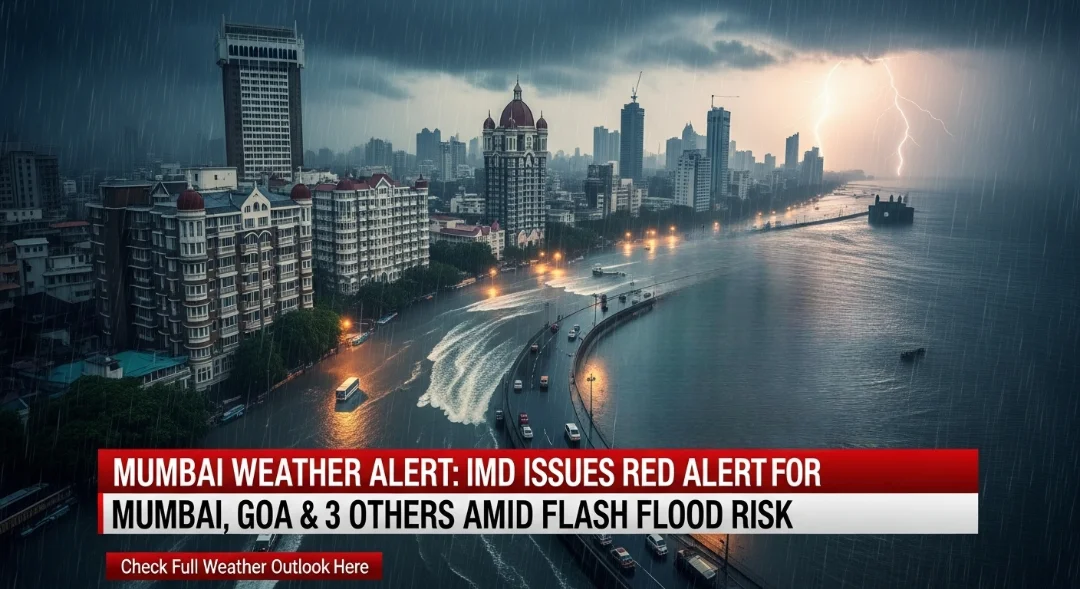If you’re in Mumbai today, you’ve likely felt the shift in the air. The usual monsoon drizzle has been replaced by a more serious downpour, and for good reason. The India Meteorological Department (IMD) has just issued a severe Mumbai Weather Alert, placing the city and several other states under a top-level Red Alert. This isn’t just a regular monsoon day; this is a clear warning for an impending high risk of flash floods and extremely heavy rainfall. For anyone living in or traveling to the region, understanding the full weather outlook is critical.
What the IMD Red Alert Means for Mumbai
The IMD Red Alert is the highest level of warning issued by the meteorological department. It signifies that the weather conditions are “extremely heavy” and have the potential to cause significant disruption and damage. In the case of this Mumbai Weather Alert, it indicates that the city is expected to receive over 20 cm of rainfall in a single 24-hour period. This kind of heavy rainfall event is what leads to waterlogging, severe traffic congestion, and, most critically, the risk of flash floods in low-lying areas. This isn’t just a forecast; it’s a direct call for preparedness.
The States Under a High-Risk Weather Alert
While all eyes are on the Mumbai weather alert, this same strong monsoon system is impacting a wide stretch of the country’s western coast. In addition to Mumbai, the IMD has issued a Red Alert for Goa, as well as the coastal regions of Karnataka, Maharashtra, and Gujarat. The entire Konkan region is currently under the influence of this intensified weather system, with forecasts of persistent heavy rainfall. This makes it a comprehensive weather alert for a huge chunk of India’s western coastline.
The Real Impact: Flash Floods and Daily Life
The primary concern with this kind of Red Alert is the potential for flash floods. Mumbai’s weather is notoriously unpredictable during the monsoon, and the city’s infrastructure can be overwhelmed by sudden, intense downpours. Key areas that might be affected include roads, railway tracks, and residential neighborhoods. This can bring the city’s lifelines, like the local trains, to a complete standstill. It’s important to understand that this weather alert isn’t just about the rain; it’s about the very real disruption to daily life.
Your Safety First: What You Should Do
In light of this serious weather alert, staying safe is the number one priority. Here are some immediate actions you should take:
- Stay Informed: Follow the latest updates from the India Meteorological Department and local authorities.
- Avoid Unnecessary Travel: It’s best to stay indoors unless absolutely necessary. Avoid walking or driving through waterlogged roads.
- Secure Your Home: Make sure your windows and doors are sealed to prevent water from entering. If you live in a flood-prone area, be ready to move to higher ground.
- Keep an Emergency Kit Ready: Have a bag packed with essentials like a flashlight, a first-aid kit, and important documents.
- Stay Away from Coastal Areas: The combination of heavy rainfall and high tides can be extremely dangerous. Avoid beaches and the seafront until the weather alert is lifted.
Conclusion
The Mumbai Weather Alert is a significant development, reflecting the severe conditions ahead. While the city and its surrounding regions, including Goa, prepare for the worst, the best course of action is to remain calm and prepared. This Red Alert serves as a crucial reminder of the power of nature and the importance of staying one step ahead. By following the advice of authorities and prioritizing your safety, you can help navigate this challenging weather event. The full weather outlook may be grim, but with the right precautions, you can ride out the storm safely.







